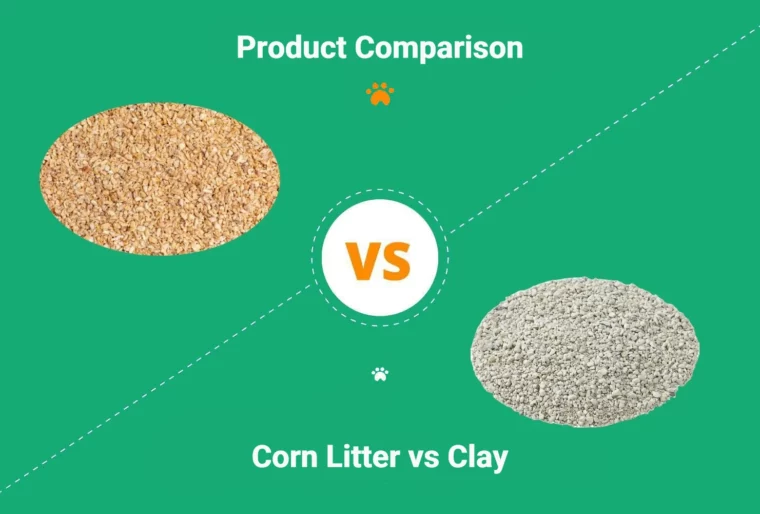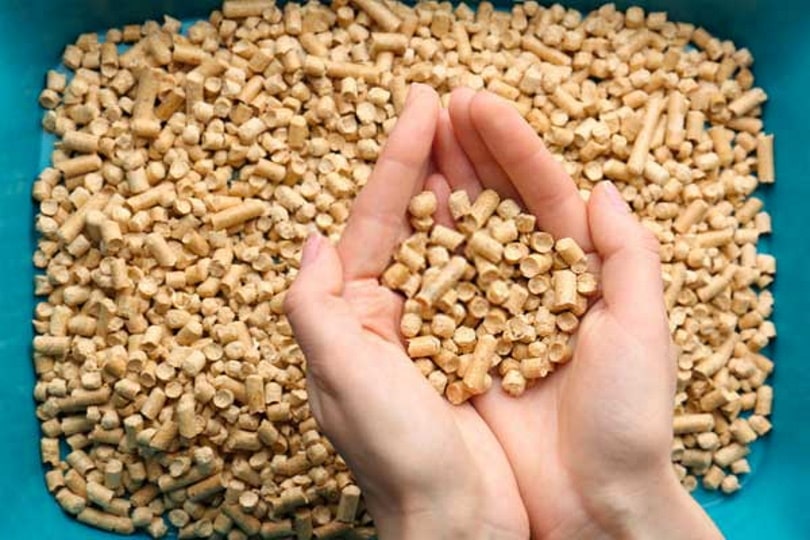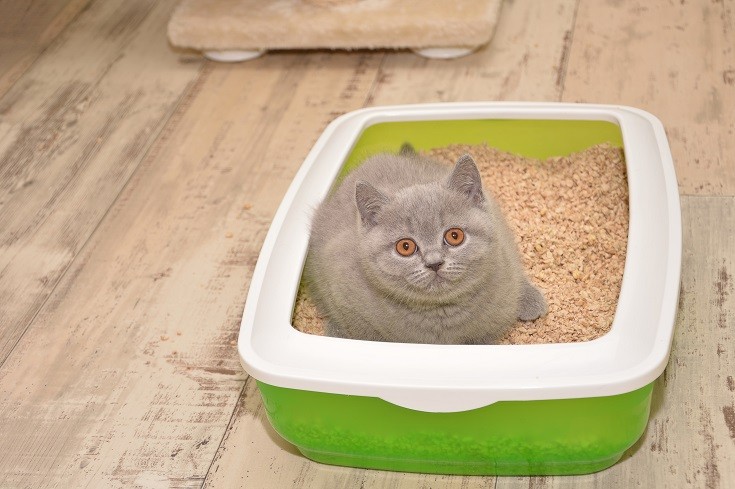
Click to Skip Ahead
When you’re bringing a cat into your home, one of the most important — and often, most overlooked — decisions that you need to make is what kind of litter to use.
There are many different options out there, and the last thing that you want to do is spend money on various litters trying to find the right one for you and your cat.
That’s why we developed this guide that will break down everything that you need to know about two of the most popular litter options out there: corn and clay.

Overview of Corn Litter

What Is Corn Litter?
Corn cat litter is just what it sounds like, a litter made from corn. It’s considered a natural cat litter, as it comes from ground-up corn cobs. Corn cobs are absorbent and make a great cat litter.
Advantages of Corn Litter
If you’re looking into corn litter, there’s a good chance that you want a natural alternative to clay litter. Corn litter is completely biodegradable and is a great environmentally friendly option for your cat’s litter box.
Corn has a few advantages over clay litter when it comes to functionality too. First, it’s not nearly as dusty and second, it’s a much lighter option. This makes it easy to complete litter box changes, and compared to clay litter, you don’t need to do them as often.
Disadvantages of Corn Litter
While there are many perks of using corn cat litter, it’s not the perfect alternative. First, there’s an increased risk of mold and aflatoxin growth. Aflatoxin is a harmful mold that grows on corn and is especially prevalent in moist environments.
It’s essential to keep up with litter box cleanings if you’re using corn litter. Moreover, while corn has a pleasant natural aroma, it’s not the best for overall odor control.
But perhaps the two biggest complaints that corn litter gets are that it’s more expensive and that it doesn’t clump as well as most clay-based litters.
Can You Flush Corn Litter?

While you can flush corn litter, you should never flush cat poop. So, if you’re flushing the litter to dispose of it, you need to scoop out the poop first.
Even then, you should only flush small quantities at a time. Sometimes your toilet won’t be able to get that much litter down at once, and you can end up creating a giant mess.
Corn Litter: Pros & Cons

Overview of Clay Litter
What Is Clay Litter?

Clay cat litter is the most common type of cat litter on the market today. Manufacturers get clay litter by strip-mining soil to get the clay sodium bentonite underneath.
Sodium bentonite is extremely effective at absorbing moisture, and this paired with the low cost of mining it makes clay litter an extremely popular choice for many cat owners.
Advantages of Clay Litter
There’s a reason that clay cat litter is the most popular option out there. It has many perks, including the price. It’s easily the most affordable and readily available kitty litter out there, and you can easily find it on the shelves at most grocery stores.
It’s also completely safe for your cat and extremely effective at urine absorption. You can get clumping options to make cleanup easier, or you can go for litter that doesn’t clump to save yourself a bit of money.
There are so many options out there, which puts you in complete control when you’re trying to find something for your pet.
Disadvantages of Clay Litter
While there are multiple perks of using clay litter, it’s far from perfect. It creates a great deal of dust when you’re moving, pouring, or scooping it, and it’s extremely heavy compared to corn litter. This is true even if you choose to spend more to get the “low dust” or “dust free” options.
Still, the most common complaint with clay litter has nothing to do with the effectiveness of the litter. It’s the fact that the process of extracting sodium bentonite from the soil is terrible for the environment.
Clay Litter: Pros & Cons

Comparing the Costs
It’s great to look at all the performance perks of each type of litter, but for many people, the most important factor is the cost. It has to fit into the budget, which is perfectly understandable.
However, it is worth noting that you can’t just look at the upfront cost of the litter when you’re trying to figure out which one is more affordable. While clay litter is cheaper, corn litter lasts longer, which means you’ll need to purchase more clay litter over time.
Most of the time, corn litter can last twice as long as clay litter, so if the clay litter isn’t half the cost of the corn litter, you’ll end up spending more in the long run.

Ease of Use
If you’re trying to figure out what litter is the easiest to use and care for, it all comes down to what you’re looking for and your personal preference.
While you should clean out corn litter every day, you don’t have to complete full changes as often, and it’s a much lighter litter.
However, clay litter clumps better, and it’s not as big of a deal if you choose to clean out the litter box every other day instead of each day. In the end, it’s up to you to decide which one is easier for you.
Your Cat’s Health
Nothing else really matters if either corn or clay cat litter isn’t safe for your cat. The good news is that if you get the right type of litter and take the time to clean and care for the litter box, these two options are completely safe for your cat.
However, there are caveats with both litters to ensure that they’re completely safe for your cat. If you’re going with corn litter, you need to keep up with regular cleanings to keep all the urine out of the box to prevent any mold build-up. We recommend cleaning out the box each day.
For clay-based litters, the problem comes in when you try to get a scented option. Cats have a much more powerful sense of smell than us, and they can’t handle most artificially scented litters. Naturally scented liters are fine but try to avoid the artificial stuff. If you’re still having an issue with smells, we highly recommend using Hepper’s deodorizing powder.
| Advantages of Corn Litter | Advantages of Clay Litter |
| Environmentally friendly and biodegradable | Affordable |
| Lightweight | Great clumping ability |
| Dust free | Many options available |
| Long-lasting | Easy to get |

Conclusion
Now that you know more about both corn and clay cat litter, it’s up to you to decide which one is right for you and your cat. There’s no wrong choice here, so get the one that you’re going to be happier with.
Just don’t wait too long, because while you can go with either corn or clay litter, you can’t go without any litter!





